Health Issues In Merle - Why To Avoid It in The American Bully Breed

What is a Merle American Bully?

Merle Bully Cost, Health Issues & Problems Associated with the Merle Gene, Merle Colors, Double Merles, Lethal Whites & Why The Merle Coat Pattern Should Be Avoided in the American Bully Breed
Health Problems Associated With The Merle Gene Mutation in the American Bully Breed
Unfortunately, the merle coat pattern is also associated with a number of serious health problems and, for that reason, is not accepted by the American Bully Kennel Club and several other associations.
In this article we’ll go into detail about the merle coat pattern — what causes it, the health problems associated with it and the reasons it’s shunned by most ethical breeders and Kennel Clubs. We’ll take a closer look at why some American Bully breeders continue to breed merle dogs in spite of the known health issues associated with it.
The debate is raging on in the American Bully community as we speak.
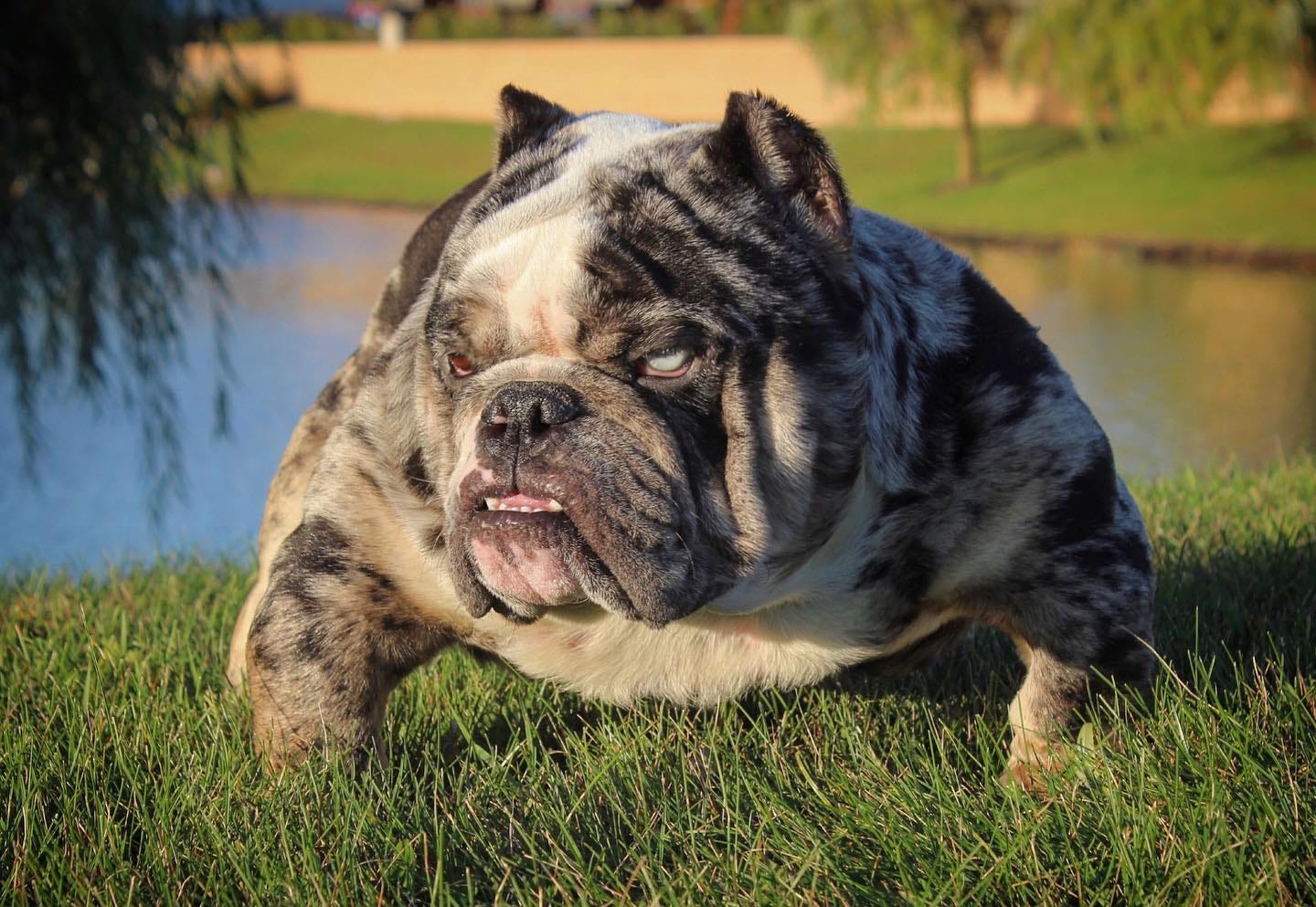

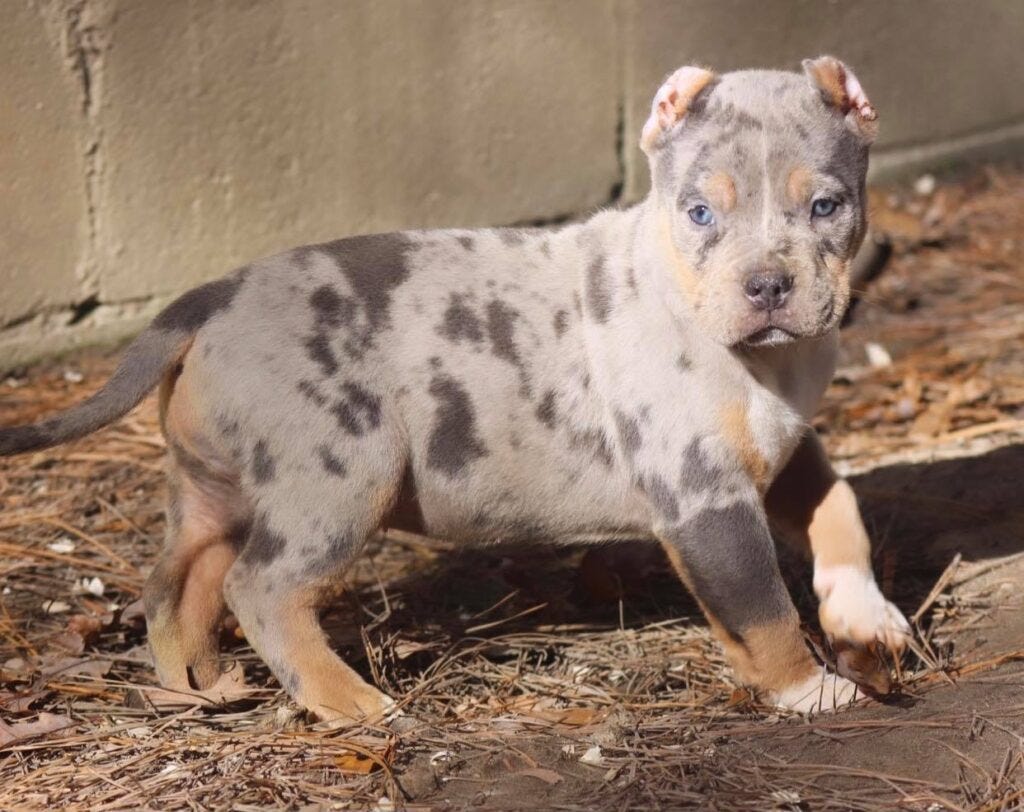
THE MERLE COAT PATTERN
In certain breeds of dog, there is a coat pattern known as ‘merle’. I is sometimes referred to as a color, but it’s actually the result of a gene altering the way pigment appears in a dog’s coat. The merle coat pattern has recently become more popular — due to it’s unusual pattern and look.
Since the merle coat pattern is unique to each individual dog — some breeders have used this as a marketing ploy or a sales tactic, attempting to lure unsuspecting buyers (especially those who are new to the breed) into paying higher prices thinking they’re actually purchasing ‘rare’ colored American Bullies.
Unfortunately, there are several health issues associated with the merle gene mutation — and the risk of these problems occurring only increases when two merle dogs are mated together.
WHAT IS MERLE?
A dog with a merle coat is characterized by having patches of hair with diluted pigment (color).
COMMON TYPES
- Blue Merle
Though a variety of merle colors are referred to by breeders and dog owners, the two most commonly seen types of merle are blue merles and red merles. Blue merles are, in fact, grey. They appear like a tri-color dog (black, white and tan), but with patches of the black appearing ‘faded’ or grey.
- Red Merle
Similarly, a red merle will have faded patches of red and will often look more mottled than the blue merle. While all of the breeds with the merle coat pattern produce blue merles, only certain breeds produce red merles. The strength of the other colors in the dog’s coat (tan and black, or red and tan) can vary as well, with some merles appearing to have extremely pale coloring all over, while others can have quite strong patches of color.
Blue merles with no tan markings at all are known as bi-blues, but a red merle does not necessarily have to have tan markings.
CRYPTIC MERLE
Merles commonly have blue eyes. Sometimes they may have one blue and one brown eye. They can also, on occasion, have two brown eyes. Sometimes dogs may appear to have normal coat coloring but are in fact still merles and will produce puppies with the merle colouration.
These are known as ‘cryptic merles’, but the exact reason why such dogs do not display the merle pattern remains unknown. This is one of the main reasons that not only do we refuse all merle dogs, but any dog with merle anywhere in it’s pedigree to the use of our studs. Even if they are not visibly merle (cryptic merles).
The merle gene is usually dominant, so a merle dog will have inherited the gene from one of its parents. While a non-merle dog (unless a cryptic) will have inherited no merle gene. For example, in a litter of mixed color puppies the non-merles will be (mm), while a merle will be (Mm), meaning it has inherited one merle gene and one non-merle gene.

HEALTH ISSUES ASSOCIATED WITH MERLE
There is scientific evidence to suggest that the merle gene can be linked to a higher rate of ocular, auditory issues in addition to skeletal, cardiac and reproductive abnormalities.
- Occular (Eye) Issues
- Auditory (Ear) Issues
- Skeletal, cardiac and reproductive abnormalities
A 2006 paper on the merle gene first published by the National Academy of Sciences of the United States of America attempted to identify the gene in dogs that caused the merle pattern.
One study reported 36.8% of dogs with the merle coat pattern (Mm) suffered hearing problems ranging from mild to complete deafness. While none of the dogs in the control group of non-merles (mm) had any hearing issues.
Another found merles had “significantly greater” frequency of eye abnormalities than non-merles. Other studies have found that the merle gene is associated with skeletal, cardiac and reproductive abnormalities.
WHAT CAUSES THE MERLE PATTERN?
The merle pattern is produced when a dog has a single copy of the M< allele.
All merle dogs have the genotype Mm — meaning they have one allele for merle and one allele for non-merle. All non-merles are mm. If you breed a merle (Mm) to a non-merle (mm) you will on average produce a litter in which a half of the puppies get the M allele so are Mm (merle) and half get the non-merle allele so are mm.
But, if you were to breed two merles together (Mm X Mm) you will produce on average a quarter mm (non-merle), a half Mm (merle) and a quarter MM (double-merle; also called double-dapple). And the double merles don’t look like typical merles. Instead, they’re mostly white with merle patches.
The main reason you want to avoid producing MM dogs is that they often have visual and auditory problems.

DOUBLE MERLE
A double merle is created when two merle dogs are bred together. It doesn’t matter what color merle or what breed they are. If two merle dogs are bred together, each puppy in the litter has a 25% chance of being born a double merle. A double merle inherits the merle gene twice. One copy of the merle gene causes a marbling effect on the coat and creates lighter spots throughout the solid color coat.
In a double merle, the marbling/lightening effect is doubled and the coat becomes predominantly white.
Double merles also have a very high chance of being deaf, blind, or both because they lack pigment where it would normally be.
Puppies that do not inherit the gene twice are considered “normal” dogs.
Their coats are normally marked and they are not plagued with hearing or vision problems. These are the pups that a breeder wants, because they can profit the most from these pups. Some breeders “cull” (kill) them at birth knowing that no one’s going to pay for a “defective” dog and selling a dog with issues would reflect poorly on their breeding program.
Several others will inevitably end up in shelters, while some end up being used as bait dogs for dog fighters. The ones that do end up in shelters, as many do, are destined for death because no one wants a “defective” dog — making adoption extremely difficult.
Some of the ones that aren’t culled, are labeled as “rare white” and sold to unsuspecting buyers.
HEALTH PROBLEMS IN “DOUBLE MERLES”
The extreme lack of pigmentation is what makes these dogs unhealthy and prone to multiple conditions. It goes along with:
- Hearing impairment — ranging from light deficits to complete deafness
- Vision impairment — up to complete blindness
- Microphthalmia: a rare condition causing very small eyeballs that sometimes have to be removed
- Skin cancer due to the lack of pigmentation and no protection from UV light

MERLE CONTROVERSY
The question many ask is — if breeding merle to merle has such a high chance of producing disabled puppies, why would anyone do it? There are several answers to this question, the first being plain ignorance.
Not everyone knows the risks of purchasing a merle American Bully or worse yet — breeding two merle dogs together. Ideally, breeders that sell merle puppies should explain the risks associated with breeding merle to merle, especially if the Customer already has a merle dog of the opposite sex.
But, as this is unlikely to happen, accidental creations of double merles will continue to occur.
CAN DOUBLE MERLE BE PREVENTED?
As long as there are merle coated dogs, double merles will be produced — either by accident or through ignorance on the part of the breeder. However, a great deal can be done to discourage the breeding of double merles and to educate the public on the dangers.
Official bodies and Kennel Clubs can lead the forefront in discouraging the deliberate breeding of double merles, but educating puppy buyers will also help. Uneducated customers are often sold double merles as ‘rare white’ or ‘albino’ versions of a certain breed, without knowing that their pup may go deaf or blind.
Equally, pet owners with two merles may breed their dogs without realizing the consequences. Spreading the word about the dangers of breeding merle to merle is, just part of the answer.

BREEDS IN WHICH MERLE IS ACCEPTED
The following breeds carry merle and are recognized by the AKC as an acceptable color:
- Australian Shepherds
- Pyrenean Shepherd
- Great Danes
- Koolies
- Collies
- Shetland Sheepdog
- Catahoula Leopard Dog
- Welsh Cardigan Corgi
- American Pitbull Terrier
- Olde English Bulldog
- Pomeranian
- Poodles
- French Bulldogs
IS MERLE ACCEPTED IN THE AMERICAN BULLY?
AMERICAN KENNEL CLUB (AKC)
Merle Coats are not accepted by the AKC in most dog breeds and are only accepted in breeds where the merle coat naturally occurs such as Leopard Dogs, and Border Collies.
The same goes for the UKC in the United Kingdom with the exception of Poodles as the UKC stopped accepting them in 2020.
AMERICAN BULLY KENNEL CLUB (ABKC)
Merle is not an accepted color in the American Bully breed according to the ABKC breed Standard. The ABKC’s stance on merle dogs is as follows: “Merle is a disqualifying fault.
- No. It’s a disqualifying fault, similar to albinism
- Disqualifying Faults: ‘Merle pattern/blotched per competition.”
PREVALENCE IN THE AMERICAN BULLY
The merle gene is being introduced into new breeds everyday. Merle is now present in Poodles, Bulldogs, American Staffordshire Terriers, American Pit Bull Terriers and American & Exotic Bullies. It’s become even more prevalent in many of the newer “designer breeds.”
The overabundance of these dogs is heartbreaking. There are rescues all over the country committed solely to rescuing merle dogs — that should speak volumes by itself. One online article on merle in the American Bully breed cites:
“these are 100% preventable. Don’t breed two merle dogs, and you won’t have double merles.”
I agree with that very general statement: “don’t breed merle to merle and there won’t be double merles.” True. Sounds good on paper as well.. Yes, if you don’t breed merle to merle, there won’t be any double merles — in that particular litter.
But what about their Customer’s litters? And their Customers? At some point, somewhere down the line — someone will breed two merle dogs together. Whether it’s done though ignorance or a breeder simply not giving a fuck— there will be more dogs born with serious, yet completely avoidable health issues.
While the self appointed “ethical merle breeders” boast online about being “responsible” merle breeders — they are still contributing to serious health issues in our breed. Yet pat themselves on the backs for indirectly contributing to the problem instead of being directly responsible.
So why is it that American Bully breeders continue to breed merle — when it’s proven to be linked to serious health problems, issues and abnormalities?
WHY AMERICAN BULLY BREEDERS BREED MERLE DOGS
- Money
Most merle breeders in the American Bully breed make the decision to purchase merle dogs or have merle litters because they heard or were told that’s “where the money’s at.” But it’s simply not true. Our studs and pups go for higher prices than the highest end merle dogs. This goes to show that quality stock will always demand a higher premium than a short term fads.
Setting health concerns aside for a second and looking at things strictly from a business perspective — merle isn’t “where the money is at.” Maybe if you were an American Bully breeder that struggled to sell pups at a decent prices— a gimmick like “rare colored” or a fad like “merle” could result in higher sales prices short term, but there’s no longevity to it.
- “Rare” & Unique Colors
The second biggest reason that breeders choose to go the merle route is the belief that there’s higher demand for “unique and rare” colors in the American Bully breed. This is true.. to an extent. Color is in right now, but it can be added without merle and the issues that come with it.
Breeders can add color without sacrificing structure, health, temperament — and have a breeding program with longevity — instead of cashing in on a short term fad, having a couple of litters then going out of business.



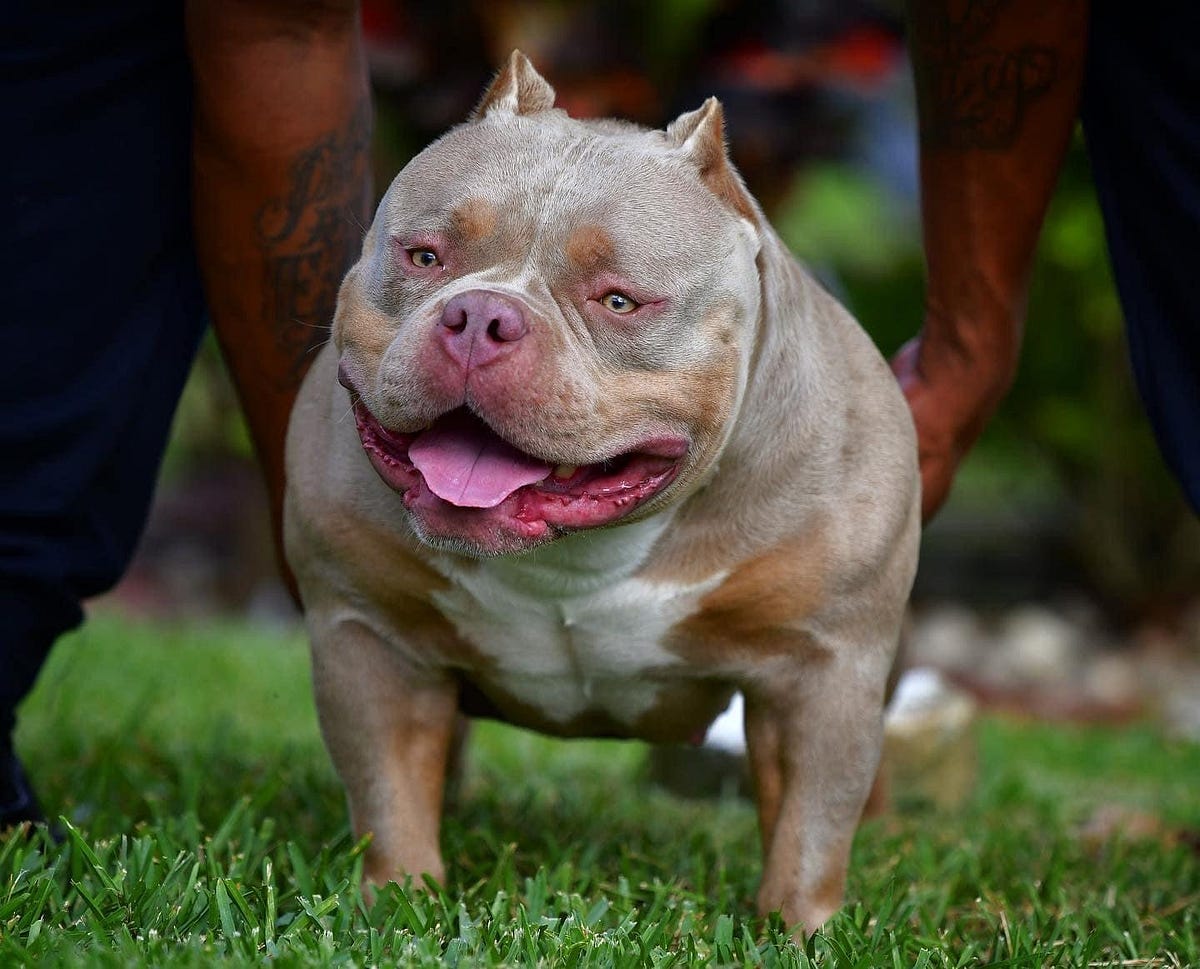
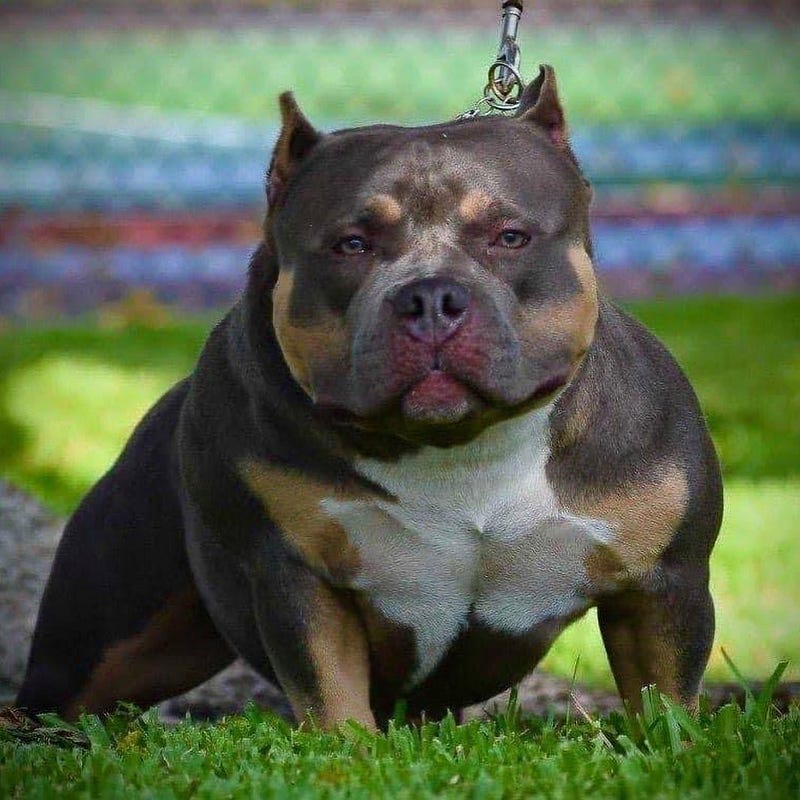
MERLE LITTERS
The first breeding (merle to non-merle) usually produces gorgeous coloring and beautiful dogs. I’d be lying if I said it didn’t. But what happens after the first few litters, is that these breeders get faced with a dilemma — breed back to merle for color and end up with health issues, or — avoid merle to merle breedings only to end up with a yard full of black & silver spotted dogs that no one wants.
It’s happening in XL’s and we’ve seen this same scenario play out 2–3 different times in American Bullies.
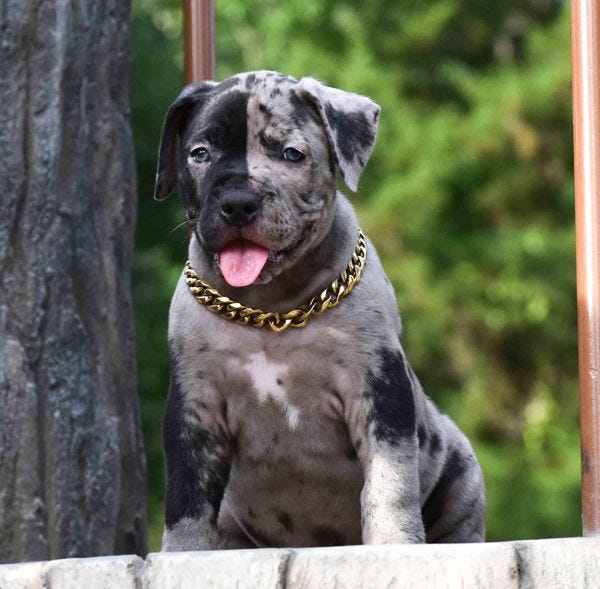
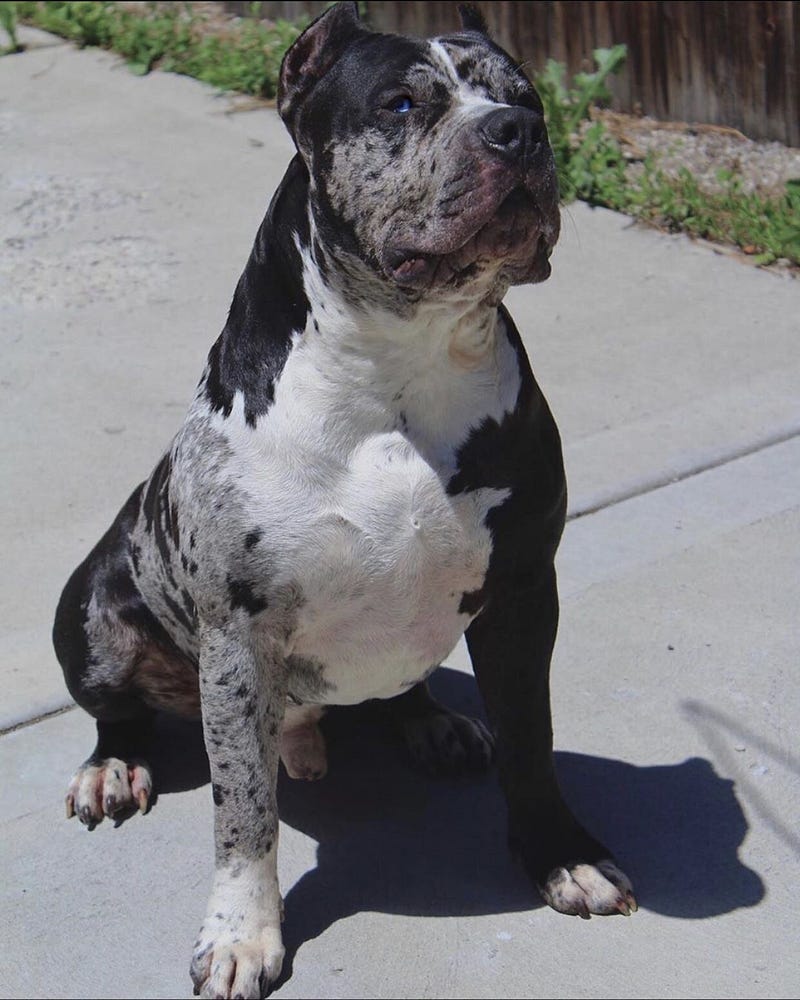
Merle isn’t new. This isn’t the first wave of merle dogs becoming popular. It’s the third or fourth wave over the past 10 years. I don’t know of a single merle breeder (from any of the 1st merle waves) that’s still in business.
They’ve had to completely start over with new stock, return to old careers or find new jobs. Here’s an article written during the last merle fad 3-4 years back. It played out exactly how I said it would — and it’ll happen again. I’m not a psychic, I don’t claim to know it all and I don’t own a crystal ball. I’ve just witnessed the same thing repeat itself over and over again.
REASONS NEW OWNERS BUY MERLE DOGS
- They Don’t Know Any Better
- They believe they’re buying “rare” color American Bullies
MERLE IN AMERICAN BULLY, EXOTIC & BULLDOG BREEDS
This article pertains to the American Bully breed, it is not referring to Exotics, French, American, English or Pacific Bulldogs, or any of the other bulldog breeds. Most of these should be considered as distinct and separate from the American Bully — with each having individual breed standards and kennel clubs to represent the breed. Along with registries that may or may not allow merle in that breed.
My concern is for the American Bully — to help educate those who might be new to the breed or considering breeding. To the ones thinking about having a litter or breeding — do your homework. Be aware of the time and cost involved before jumping in blindly. Have a set plan and an emergency back up one in place. Understand that it’s your responsibility to place pups that you bring into the world, into good homes with responsible owners.
Stop introducing new health issues that are both unnecessary and completely avoidable. I’ve turned down more ABKC registered merle dogs wanting to use our studs in the past month than all of last year. And not a single one was made aware of the health issues with merle.. None were informed about the dangers of merle to merle breedings by the breeders that sold them the dog.
SUMMARY
Although they’ve been popping up on social media sites and advertised as “rare colored” American & Exotic Bullies — the Merle coat pattern is not rare. It’s the result of a gene mutation and riddled with health problems.
Merle is a fad, nothing more. And it’s not anything new. This is the third or fourth wave of merle becoming more popular in the American Bully breed over the past 10 years. Ask any merle breeder from the first few waves how it worked out for them — oh wait.. you can’t. Because there aren’t any of them left.
The American Bully is a wonderful, loyal and kind dog no matter the color of its coat, but when that color is bred only to suit the fancy of a small group of people it becomes both immoral and unethical. Responsible American Bully breeders should refuse to breed with, or stud to merle dogs.
Merle is a passing fad that, hopefully, will end sometime very soon.
For further reading check out Becoming An American Bully Breeder: Part I & Part II, we suggest first reading those before returning back to this article.
We have included links to each below:
- AMERICAN BULLY BREEDING PART I:DECIDING ON A CLASS
- AMERICAN BULLY BREEDING PART II: PURCHASING FOUNDATION DOGS
THE AMERICAN BULLY BREED

AMERICAN BULLY BREED ORIGIN
The American Bully breed was created around 1990 and gained recognition and establishment in 2004 with the inception of the American Bully Kennel Club , also known as the ABKC Registry .The United Kennel Club or UKC recognized the American Bully breed in 2013. There are other registries, but for the purposes of this article we will mention the main few- which are the ABKC , BBCR. BRC Global and the UKC.
THE ABKC
According to the ABKC- The American Bully breed has been selectively bred to give America’s breed, the American Pit Bull Terrier, a new direction and outlet. Like with the American Staffordshire Terrier (which is also an offshoot of the American Pit Bull Terrier) all of the positive characteristics of the breed’s ancestry were kept.
BREED INFLUENCES
According to the UKC- The American Bully breed was subtly influenced by the infusion of several other breeds, which include the American Bulldog, English Bulldog, Pacific Bulldog as well as the Olde English Bulldogge among other Bulldog breeds.

AMERICAN BULLY TEMPERAMENT
Despite the American Bully’s fierce and powerful appearance their demeanor is gentle, making the American Bully an excellent family companion. The breed is known for having an affinity towards children and for an innate ability sync in on the emotions of their owners.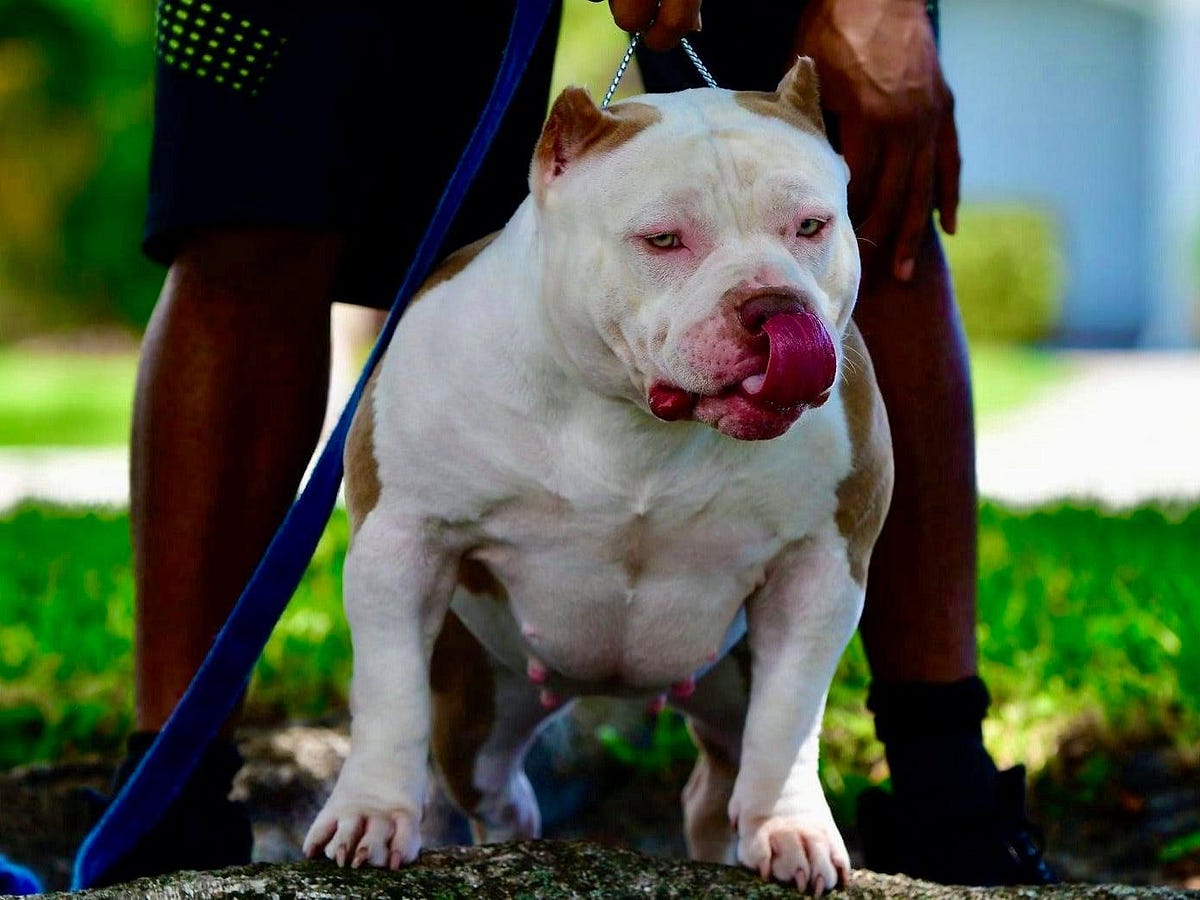
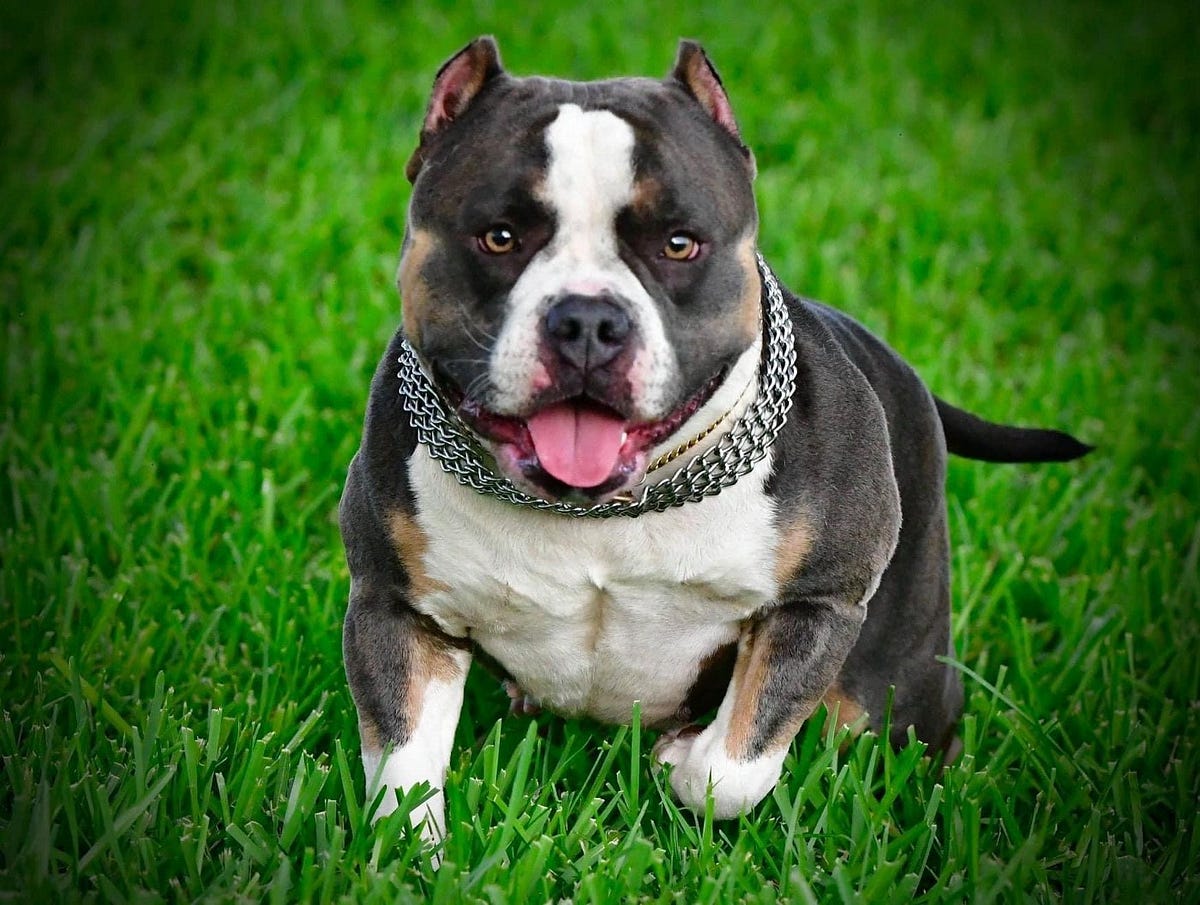
EXPLOSION IN POPULARITY
The American Bully first became one of the fastest growing new breeds in 2014 and it has remained in the Top 5 every year since.VENOMLINE POCKET BULLIES
THE POCKET AMERICAN BULLY STUDS OF VENOMLINE
VENOMLINE FEMALES
POCKET BULLY PUPPIES

UPCOMING POCKET BULLY BREEDINGS
Please Visit our Website & Join Our Mailing list to be the first to know — about newly announced Upcoming Breedings, Available Puppies for Sale & info on our World Class StudsVENOMLINE POCKET BULLY LITTERS
Check out some of our previous Pocket American Bully litters in the playlist below.
VIDEO
HOW TO CONTACT VENOMLINE
- Call/Text 832–452–0898
- Text is always best for fastest response.
- Please Visit Pups for Sale, Upcoming Breedings, How Stud Service Works, & Available Studs for Pricing & Availability before Contact.
For International Customers interested stud service (importing semen) please text 832.452.0898.
We no longer check WhatsApp due to the # of messages. Thank you.

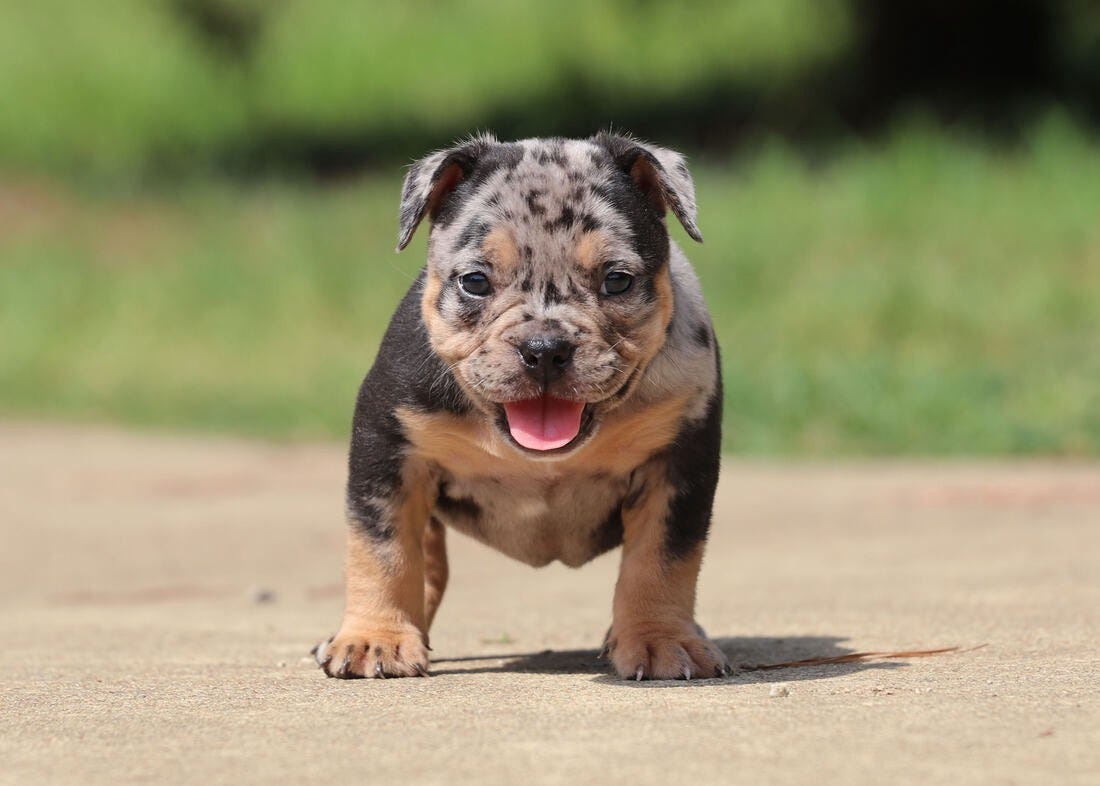
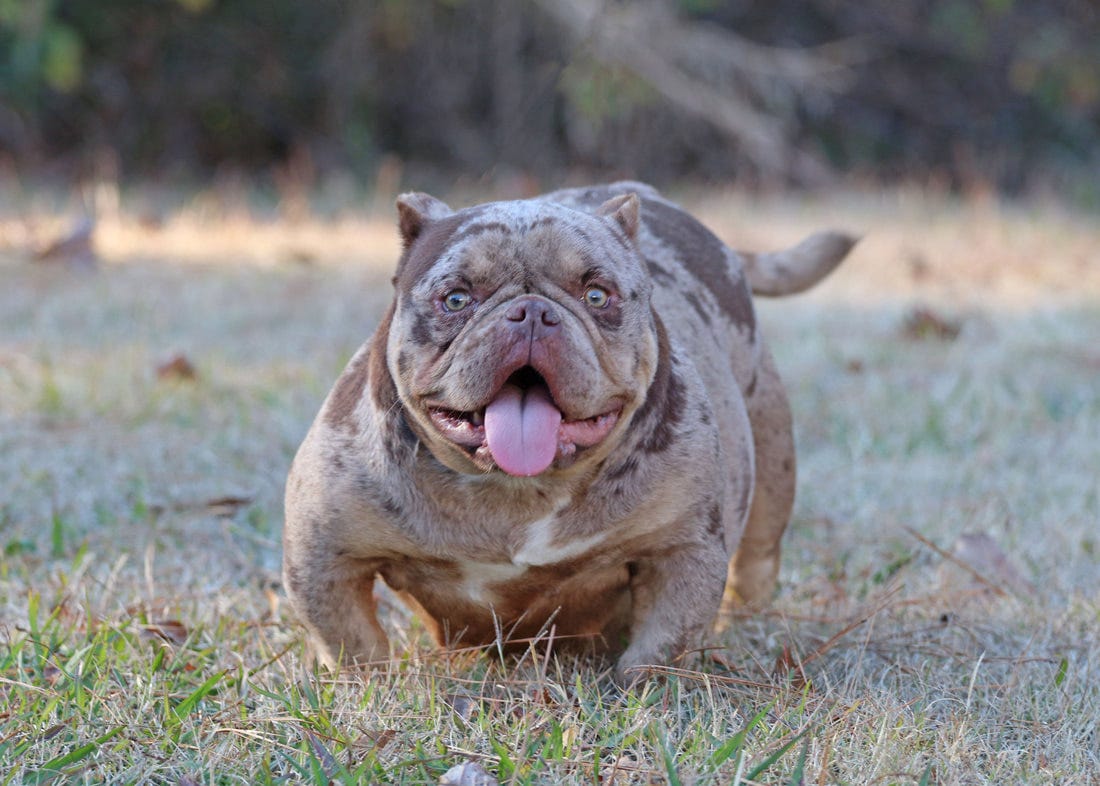

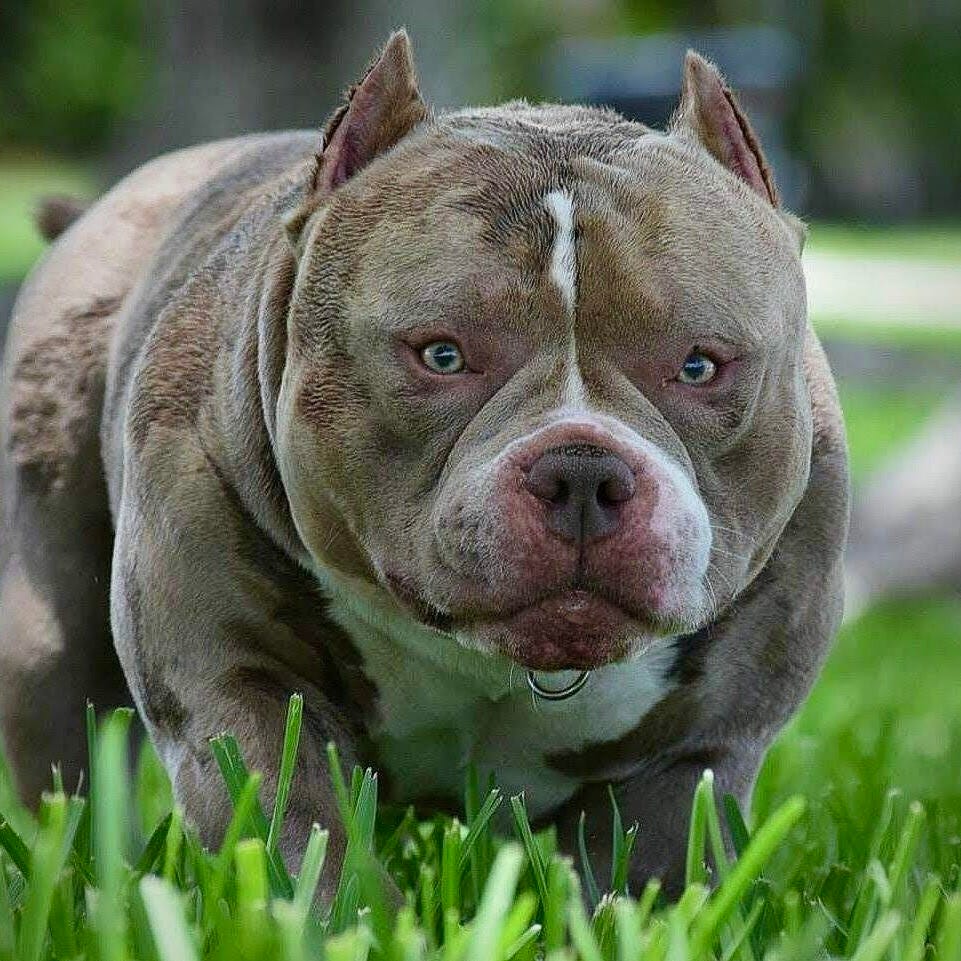
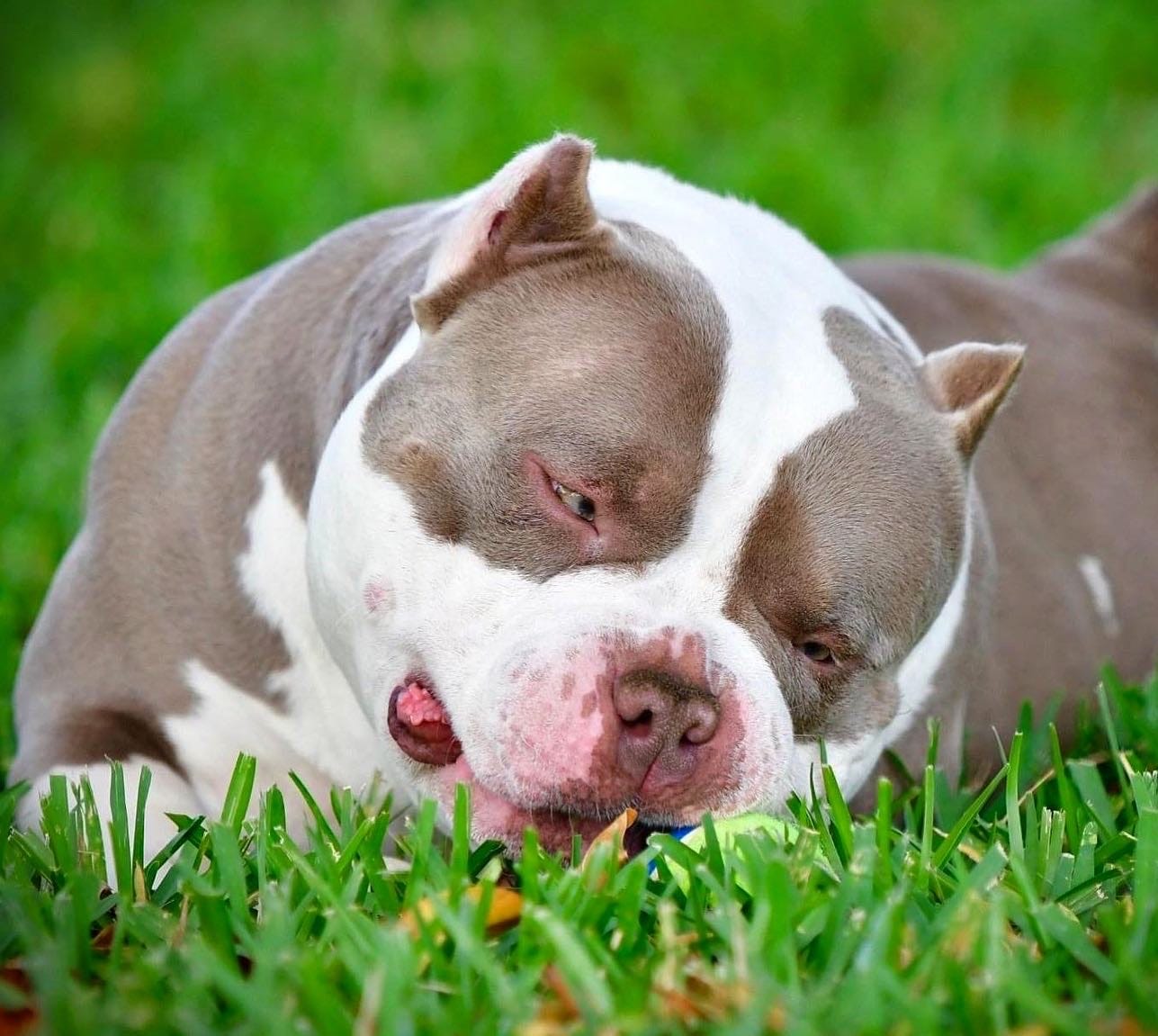



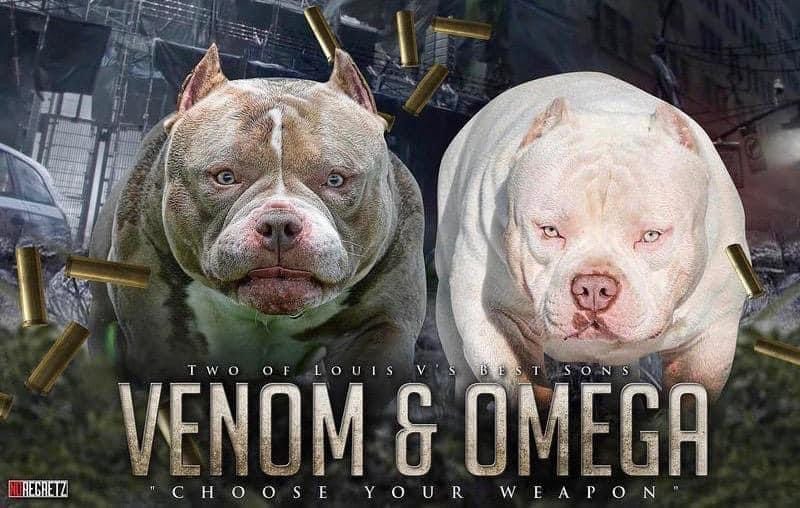
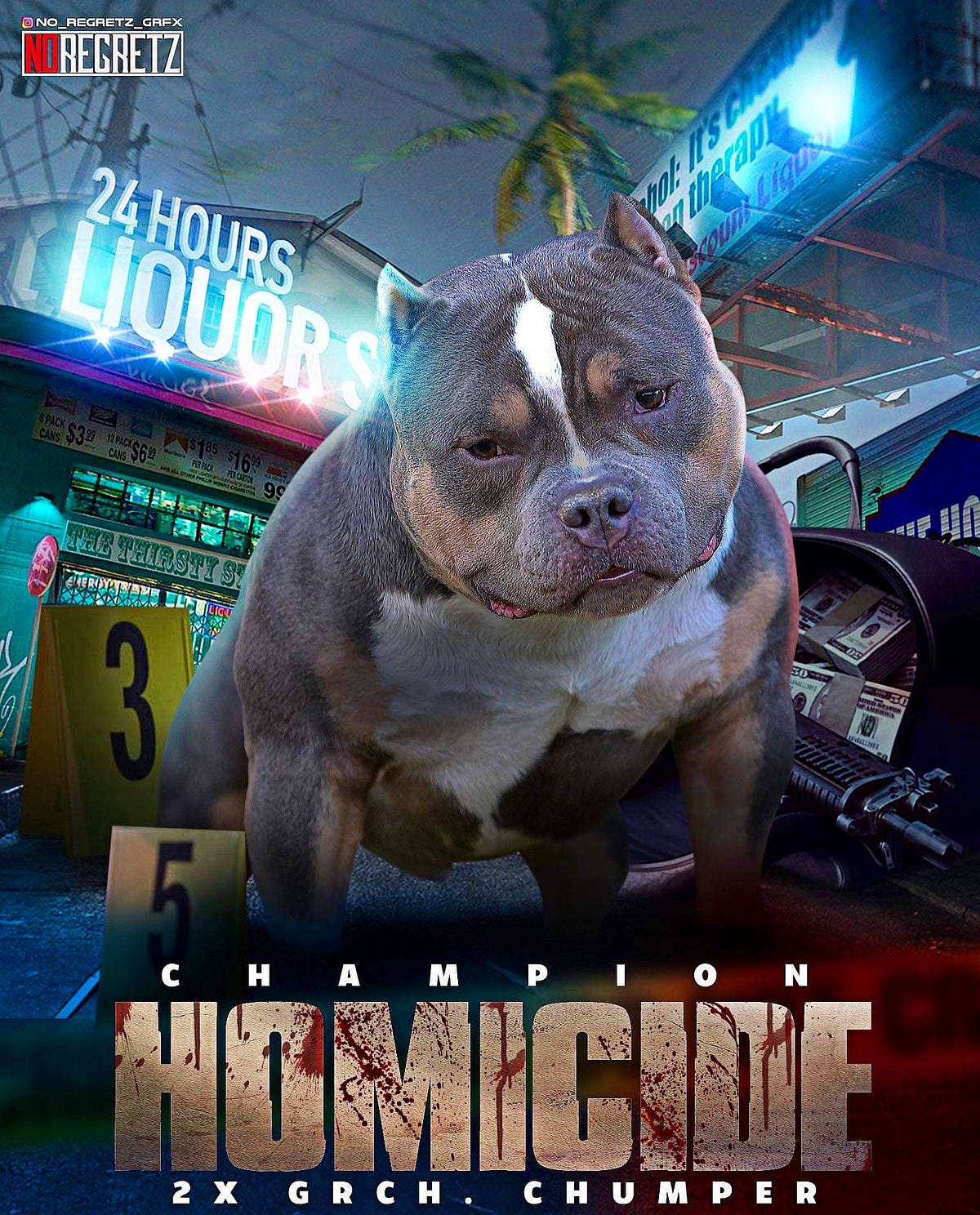

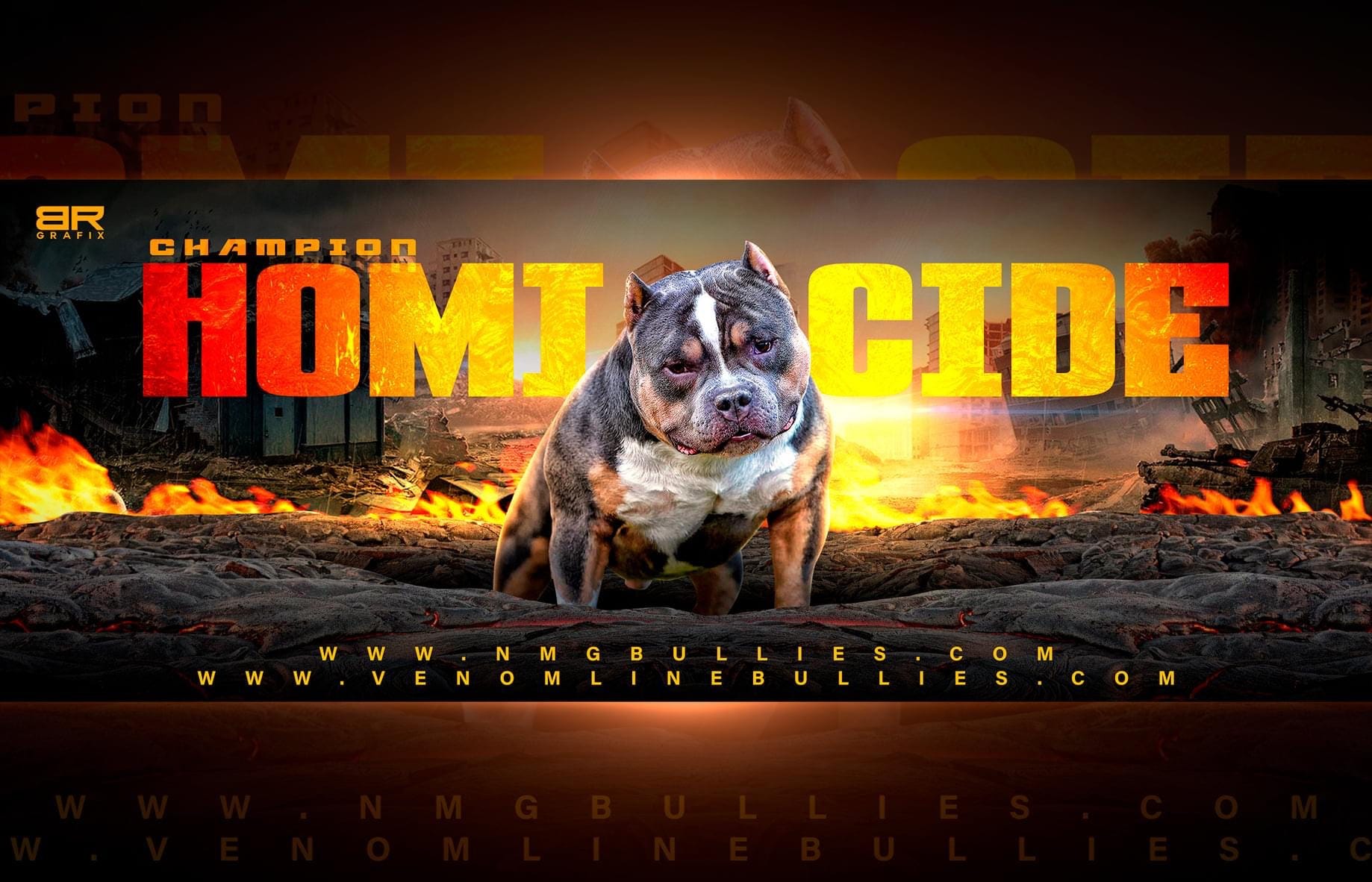
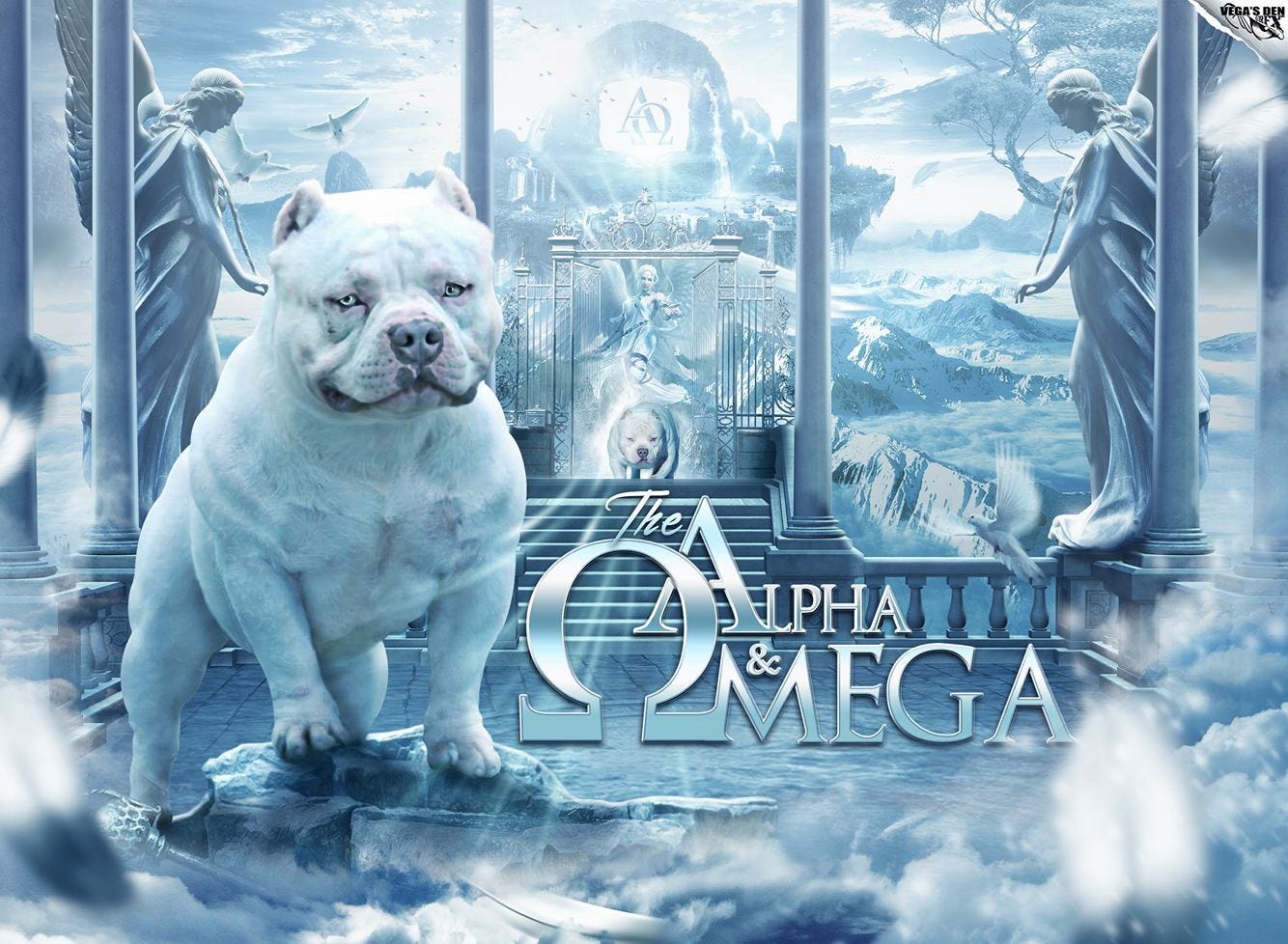

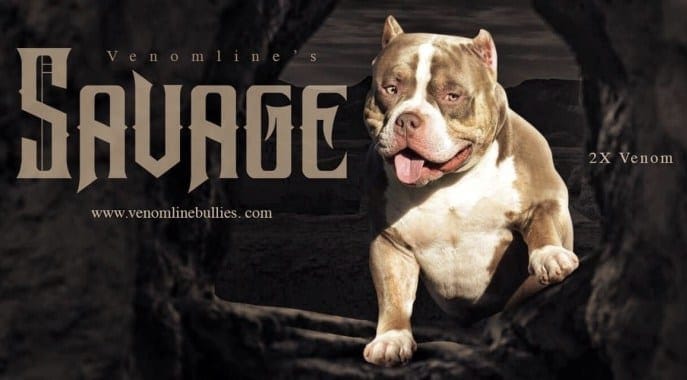


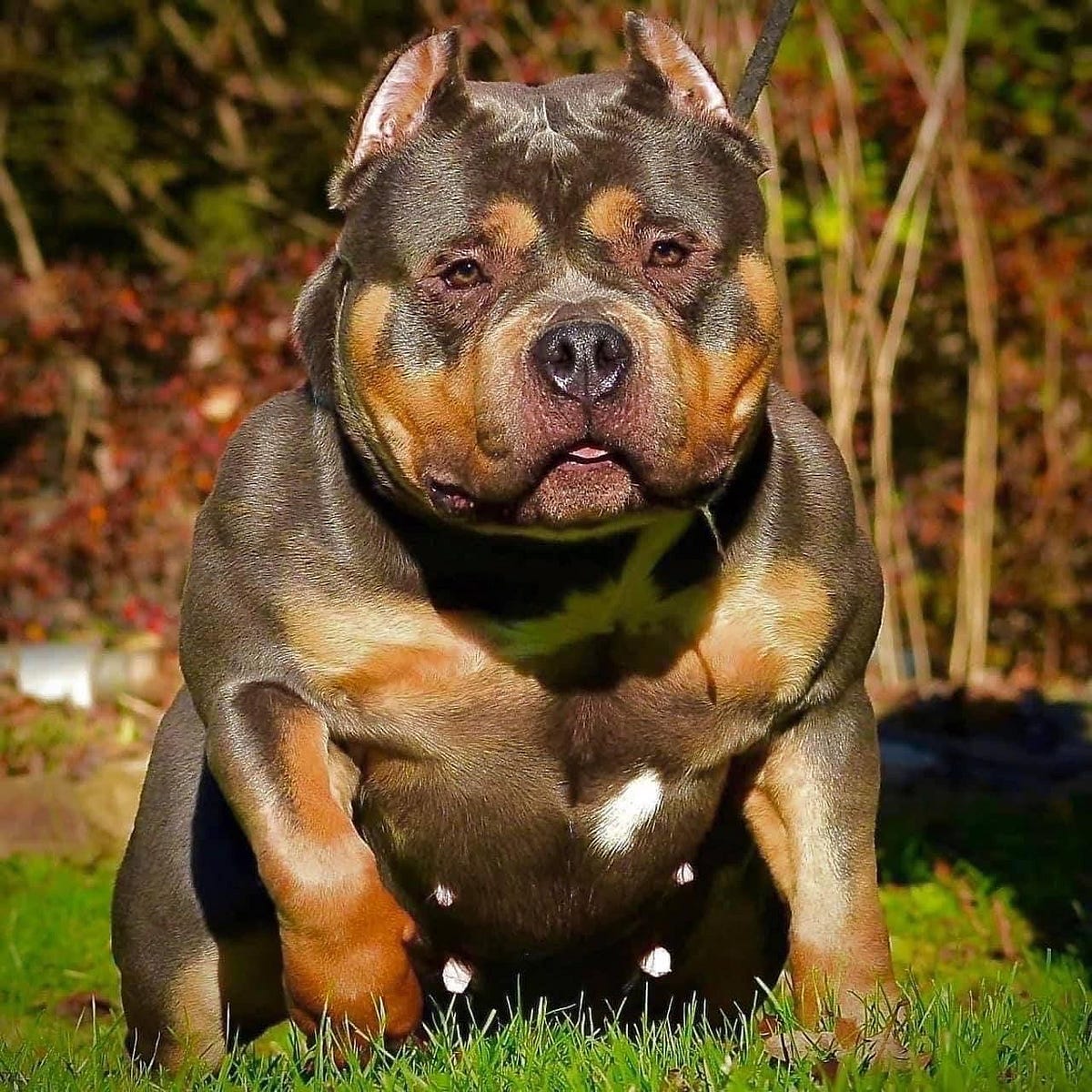
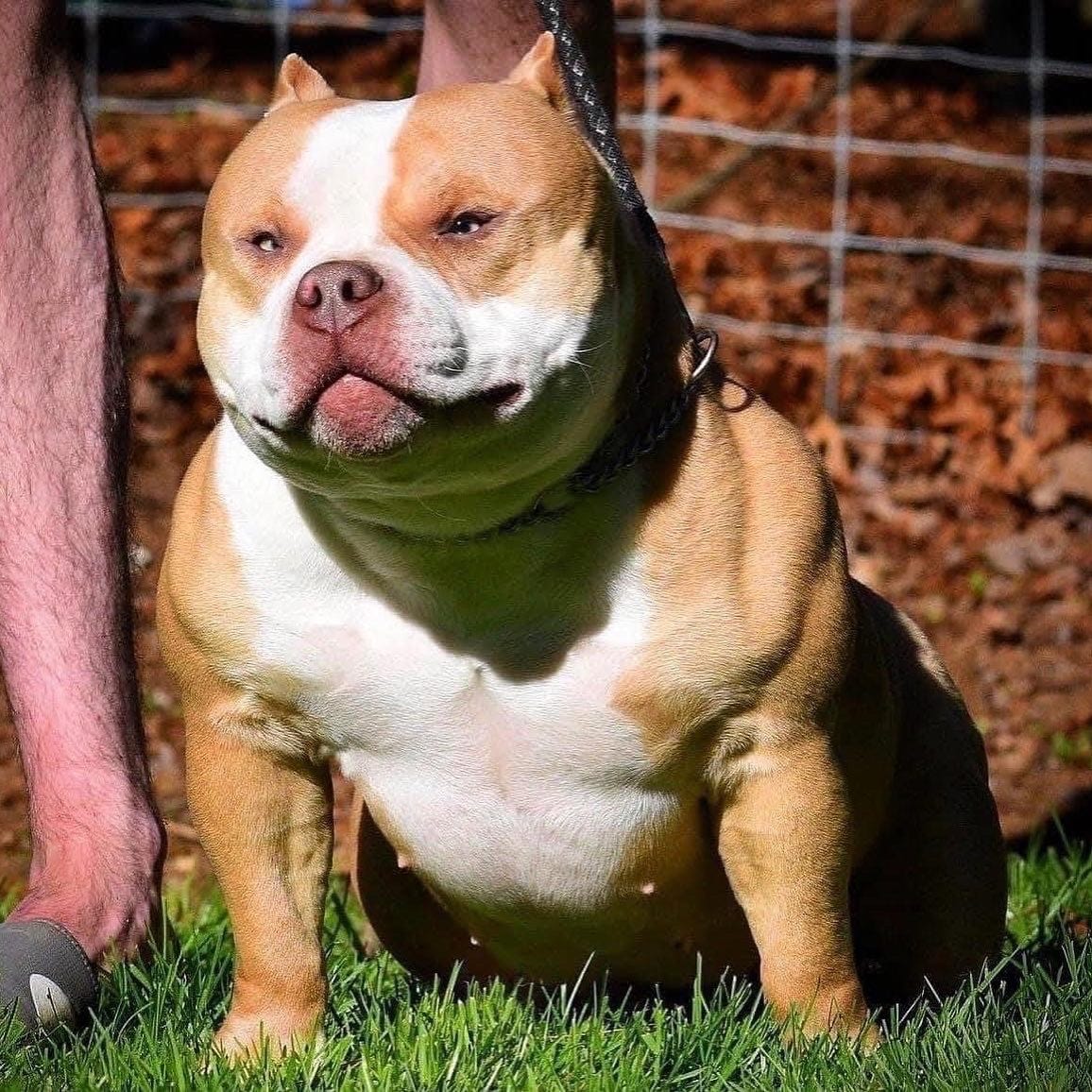
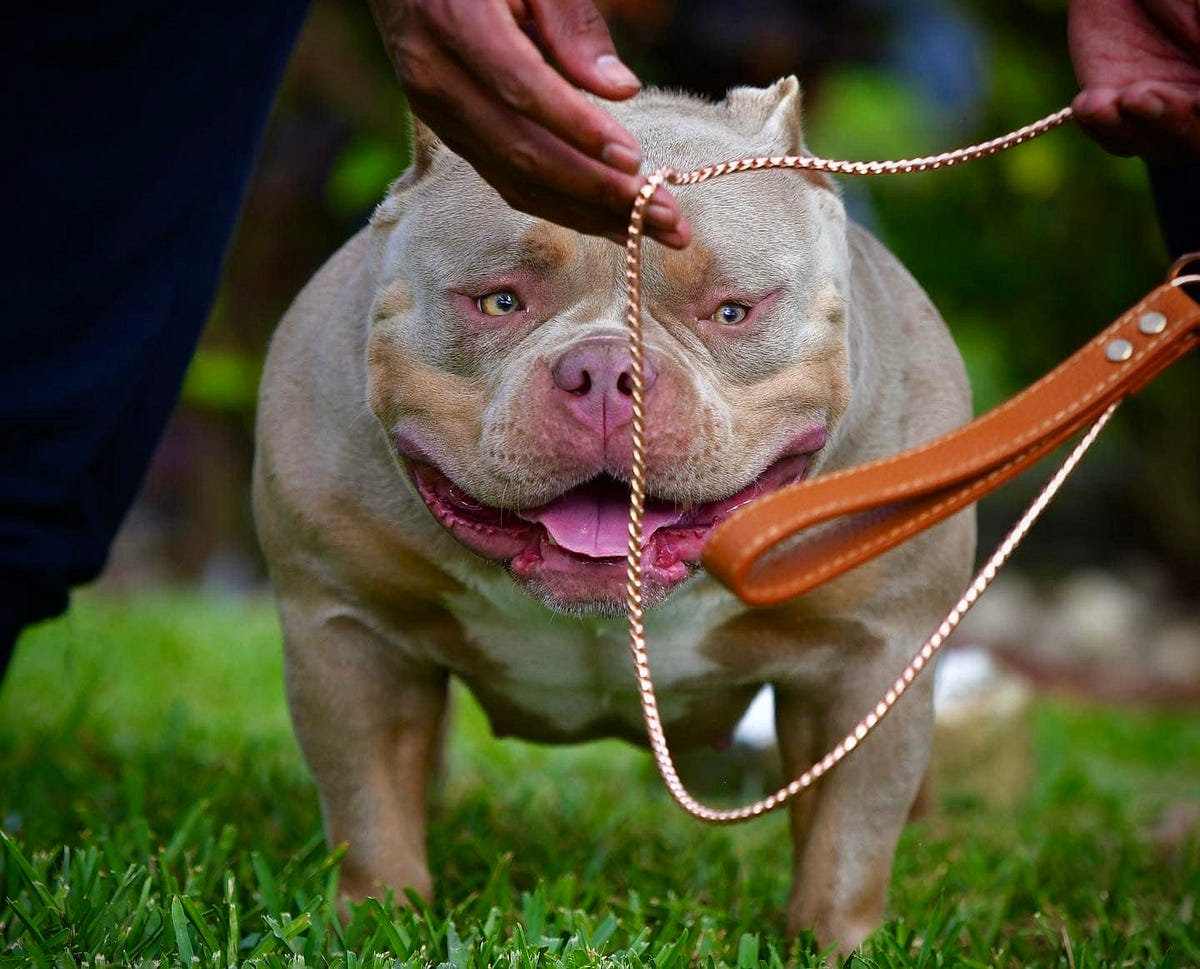
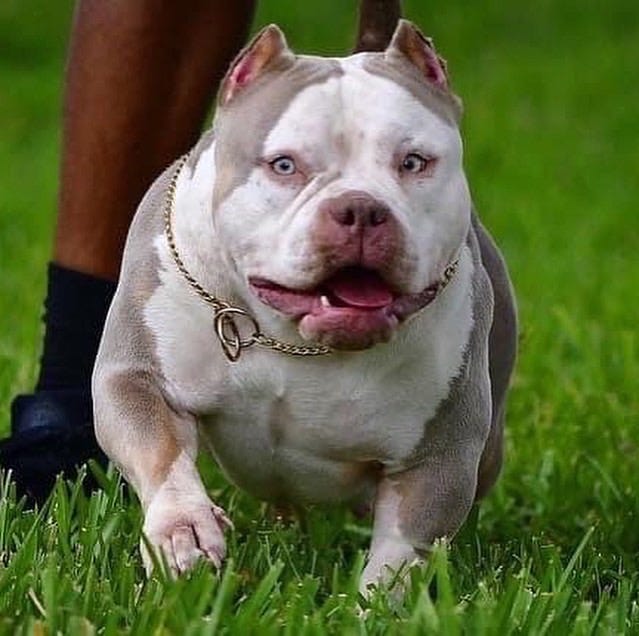
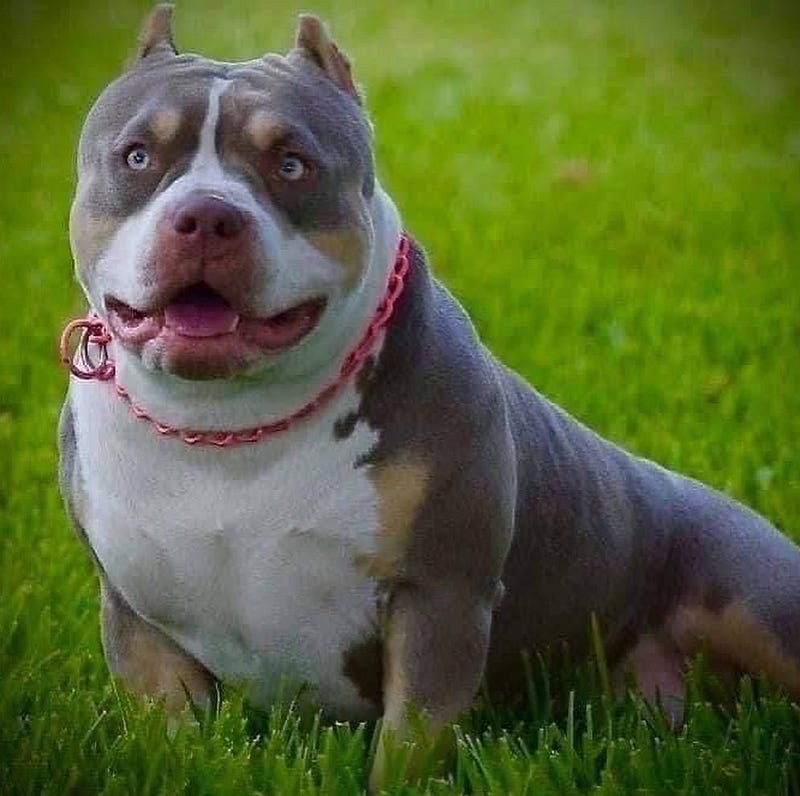
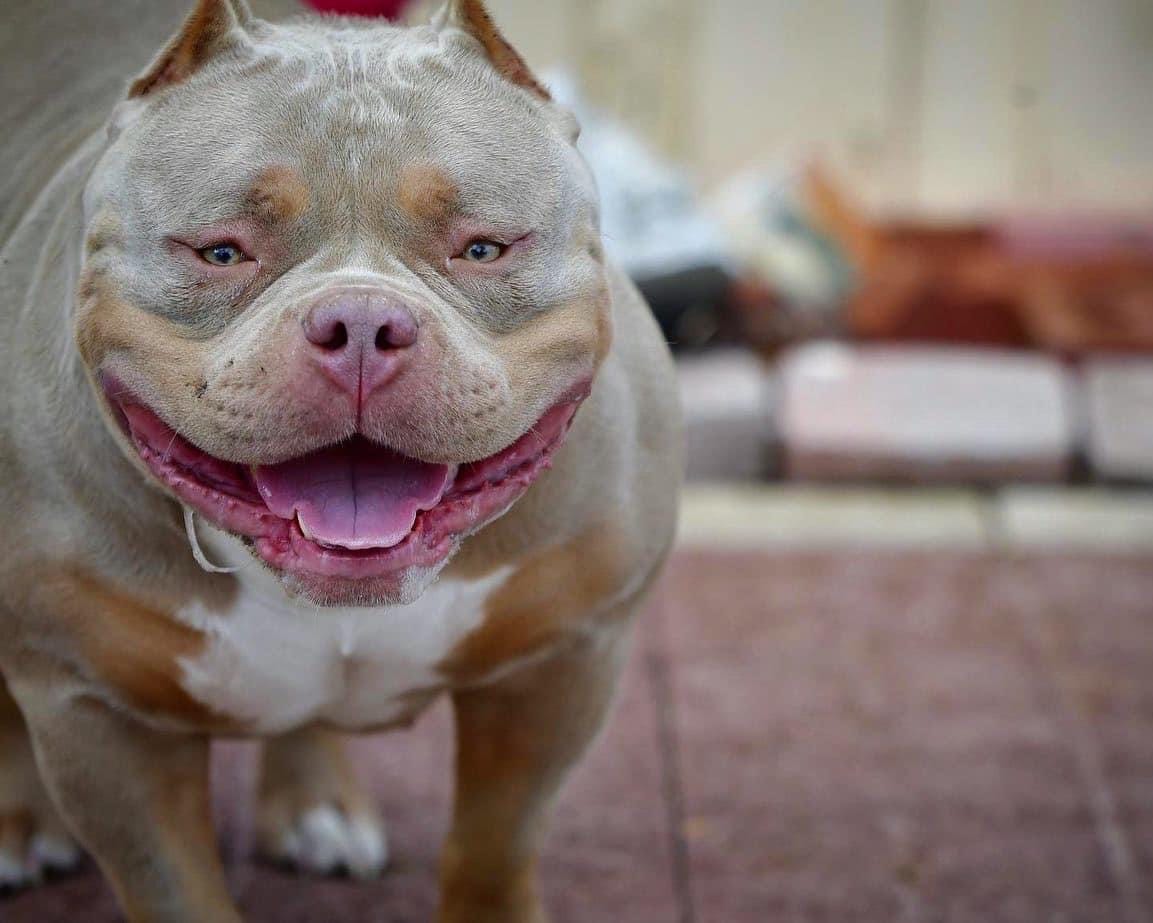



Comments
0 Comments